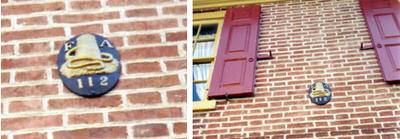
Benjamin Franklin, an advocate of fire safety in the home, wrote an article in his Gazette suggesting: “In the first Place, as an Ounce of Prevention is worth a Pound of Cure, I would advise ‘em to take care how they suffer living Coals in a full Shovel, to be carried out of one Room into another, or up or down Stairs, unless in a Warmingpan shut; for Scraps of Fire may fall into Chinks and make no Appearance until Midnight; when your Stairs being in Flames, you may be forced, (as I once was) to leap out of your Windows, and hazard your Necks to avoid being oven-roasted.”
This was sound advice from Mr. Franklin who was one of the first to suggest the need for a body of men who would be available to fight a fire, perhaps a “Club or Society of active Men belonging to each Fire Engine; whose Business is to attend all Fires with it whenever they happen.”
On a recent trip to Philadelphia and a tour around the historic district, I was pleased to see that many old buildings have retained the original fire marks of their respective insurance companies, some of which began in England and then moved to America. These new businesses were both lucrative and competitive. On acceptance of a policy, the insurance company installed their fire mark on the insured building, usually on the first floor where it could easily be seen. Originally, the fire marks were made of lead and cast in a mold with the insurance company’s number under a unique emblem. They were decorated in bright colors and sometimes included a gold leaf accent. However, from 1780 to 1800, the high cost of lead made the fire marks too expensive, so copper, tin or a mixture of metals was used. Fire marks designs varied considerably with each insurance company. The Fire Association of Philadelphia (c. 1817) displayed a hose wrapped around a pump while the Insurance Company of North America depicted an eagle and a hose.
Insurance companies organized their own fire brigades to protect their clients’ properties. The men of these brigades were chosen for their strength and disposition. They wore magnificent, colorful uniforms that easily distinguished members of one brigade from another. The men of a brigade were proud and often gregarious by nature. When an alarm sounded, each brigade set off to discover the whereabouts of the fire. If the building displayed a rival’s fire mark, the brigade not only let the property burn, but actually impeded the legitimate brigade’s attempts to douse the fire by kicking over their competitors’ leather buckets, swearing or physically fighting while the building burned to the ground.
Anyone who saw the movie Gangs of New York might remember there was just such an incident where rival firefighters literally took to fisticuffs over a fire as the building was razed to the ground.

